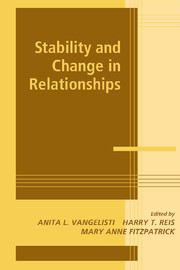Book contents
- Frontmatter
- Contents
- Contributors
- Preface
- PART ONE ACTORS: THE SCAFFOLDING OF STABILITY AND CHANGE
- PART TWO BEHAVIORS: THE PROCESSES OF STABILITY AND CHANGE
- 5 Serial Arguing over the Relational Life Course: Antecedents and Consequences
- 6 Communication, Relationship Concerns, and Satisfaction in Early Marriage
- 7 Sacrifice in Romantic Relationships: An Exploration of Relevant Research and Theory
- 8 Stability and Change in Social Relations: Perspectives from Gerontology and Stress Research
- 9 What Microanalysis of Behavior in Social Situations Can Reveal about Relationships across the Life Span
- 10 Developing a Multifaceted View of Change in Relationships
- PART THREE CONTEXTS: SOCIAL ENVIRONMENTS FOR STABILITY AND CHANGE
- Author Index
- Subject Index
6 - Communication, Relationship Concerns, and Satisfaction in Early Marriage
Published online by Cambridge University Press: 21 October 2009
- Frontmatter
- Contents
- Contributors
- Preface
- PART ONE ACTORS: THE SCAFFOLDING OF STABILITY AND CHANGE
- PART TWO BEHAVIORS: THE PROCESSES OF STABILITY AND CHANGE
- 5 Serial Arguing over the Relational Life Course: Antecedents and Consequences
- 6 Communication, Relationship Concerns, and Satisfaction in Early Marriage
- 7 Sacrifice in Romantic Relationships: An Exploration of Relevant Research and Theory
- 8 Stability and Change in Social Relations: Perspectives from Gerontology and Stress Research
- 9 What Microanalysis of Behavior in Social Situations Can Reveal about Relationships across the Life Span
- 10 Developing a Multifaceted View of Change in Relationships
- PART THREE CONTEXTS: SOCIAL ENVIRONMENTS FOR STABILITY AND CHANGE
- Author Index
- Subject Index
Summary
Longitudinal studies are undoubtedly critical to understanding the developmental course of marriage (Bradbury, 1998; Karney & Bradbury, 1995; Kurdek, 1998). This type of research can provide a more accurate and sensitive assessment of relationship functioning over time, with each couple being used as their own controls. Further, as Bradbury notes, longitudinal studies “have the potential to explain how marriages succeed and fail rather than simply describe the differences between couples who are already distressed and those who are not” (p. 3).
Several groups of researchers have carried out longitudinal studies of marriage, focusing primarily on the link between communication and relationship satisfaction. In these studies, however, communication has often been measured at only one point in time, with satisfaction being measured at several other times. A study by Huston and Vangelisti (1991) is an exception to this pattern, as they assessed both socioemotional behaviors and relationship satisfaction at all three waves; however, self- and partner reports were obtained by telephone interview, rather than by observing actual communication patterns. Researchers' claims that communication patterns are stable over time have often been made on the basis of indirect evidence; for example, the extent to which communication at one point in time can predict satisfaction at a later time.
Some longitudinal studies have also been prone to a range of other criticisms, such as not distinguishing between first and second marriages or between childless couples and parents, or failing to analyze the data separately for husbands and wives (Karney & Bradbury, 1995; Kurdek, 1998).
- Type
- Chapter
- Information
- Stability and Change in Relationships , pp. 129 - 155Publisher: Cambridge University PressPrint publication year: 2002
- 12
- Cited by



